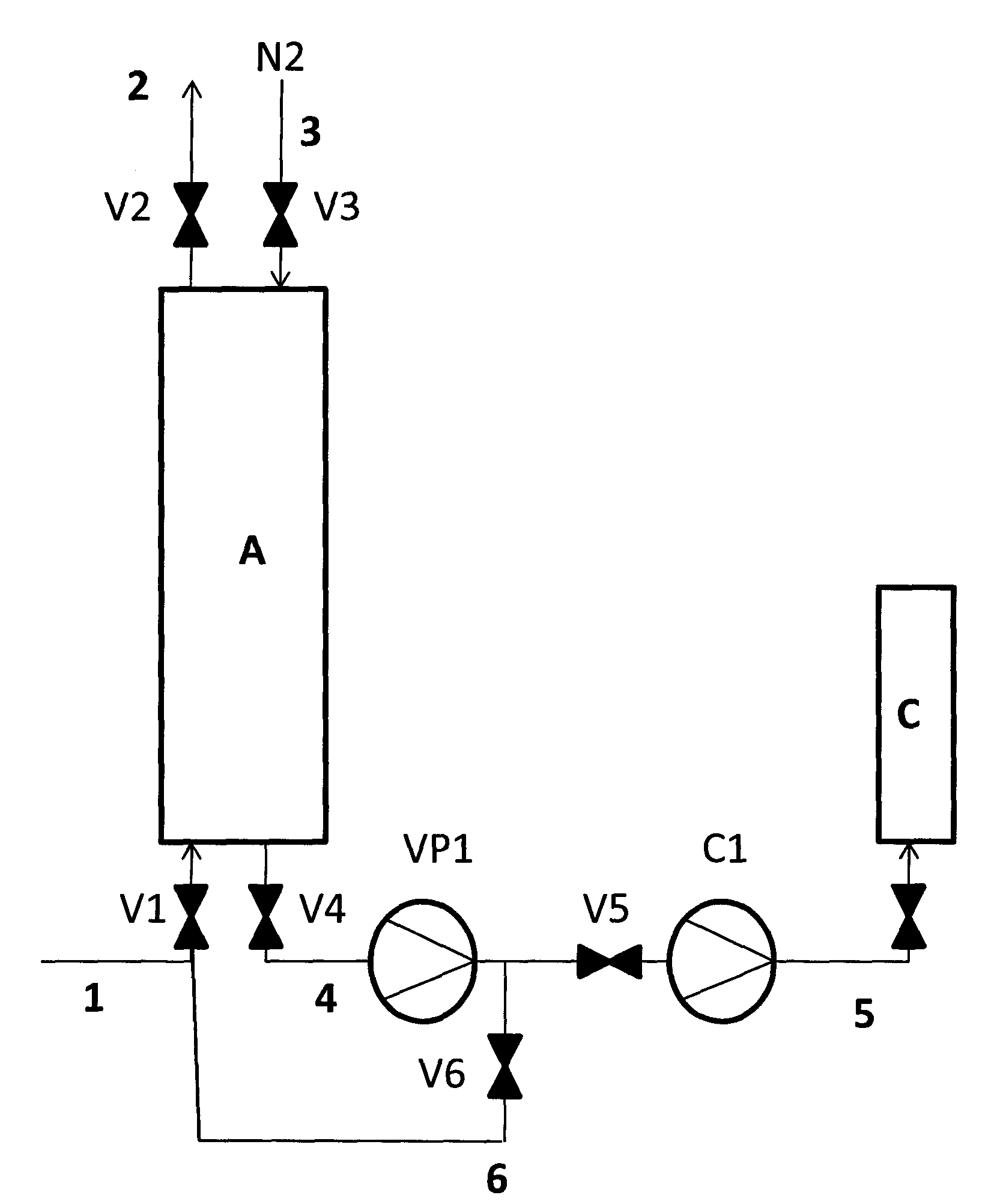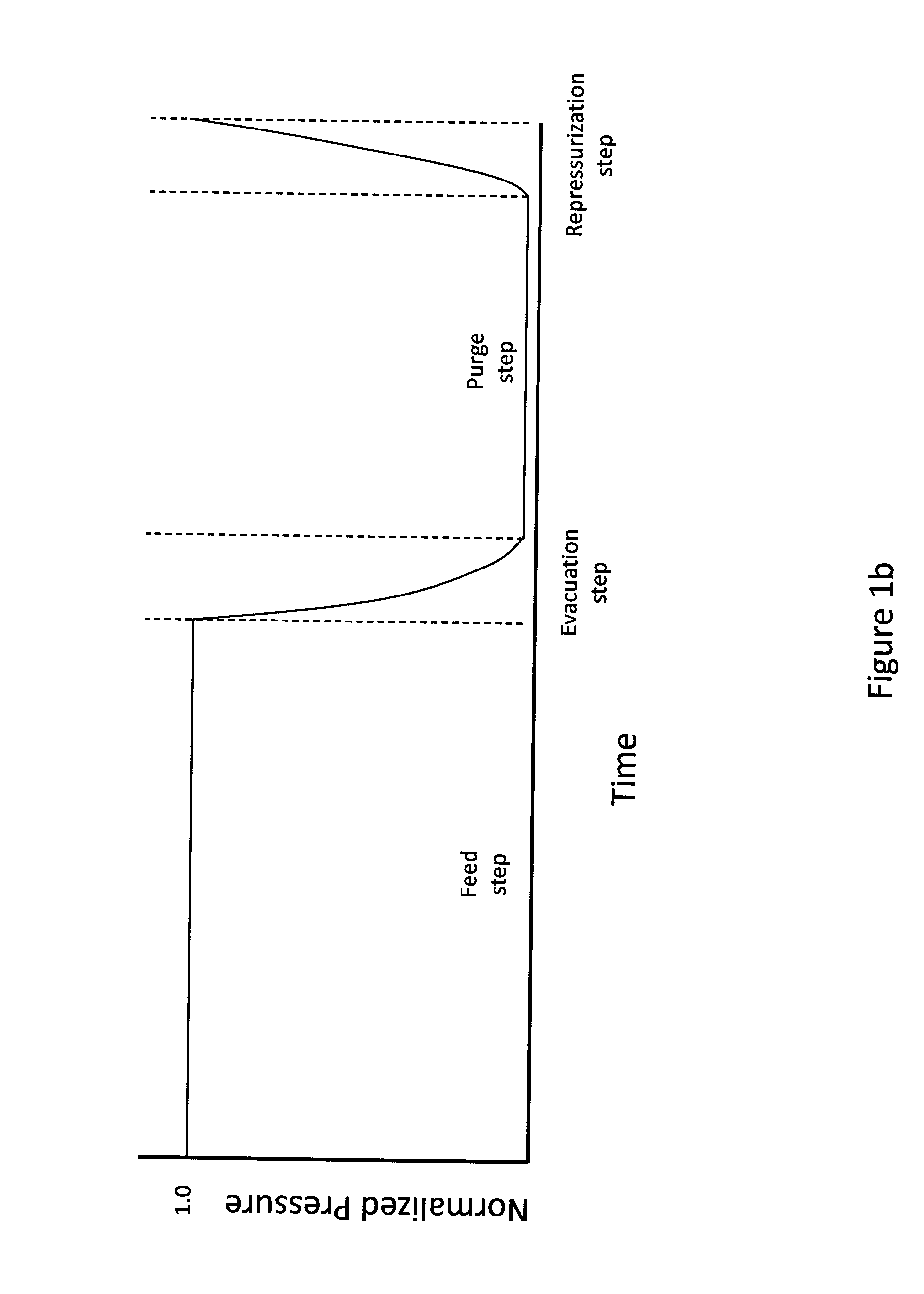Recovering of xenon by adsorption process
a technology of adsorption and xenon, which is applied in the direction of separation process, dispersed particle separation, products, etc., can solve the problems of xenon shortage and the potential barrier to increasing xenon utilization, and achieve the effect of reducing the cost of xenon
- Summary
- Abstract
- Description
- Claims
- Application Information
AI Technical Summary
Problems solved by technology
Method used
Image
Examples
working examples
Example 1 (Comparative)
Xenon Recover by a Typical Vacuum Swing Adsorption (VSA) Process
[0062]The total gas flow rate and xenon concentration measured at the exit of vacuum pump VP1 in FIG. 1a were shown in FIG. 2.
[0063]Gas flow rate was measured using a Mass Flow Meter (MFM), while Xe concentration was measured using a quadrupole mass spectrometer (QMS). The QMS is capable of estimating dynamic xenon and nitrogen gas compositions, but the device is not particularly precise. Measured values of xenon and nitrogen mole fraction have uncertainty range of about 10-20%.
[0064]At time 0 minutes, the evacuation step started by closing valves V1 and V2 then starting the vacuum pump VP1 and opening valve V4 in FIG. 1a. There was an instantaneous gas flow rate of >180 slm as the N2 contained in the adsorbent vessel and void space was evacuated. It took about 2 to 3 minutes for the pressure in the adsorbent vessel A to drop from atmospheric pressure to <10 torr.
[0065]As shown in FIG. 2, the comp...
example 2
Xenon Recover by an Improved Vacuum Swing Adsorption (VSA) Process
[0075]It was discovered from analysis of the data in FIG. 2 that Xe could be recovered from the VSA process at significantly higher purity by collecting the Xe after the initial evacuation of N2 from the vessel void space.
[0076]An improved Vacuum Swing Adsorption (VSA) recovery process is shown in FIG. 5a. The process still has four steps: feed, evacuation, purge, and repressurization.
[0077]FIG. 5b illustrates the gas pressure maintained in adsorption vessel A during the improved VSA recovery process.
[0078]The flow chart showing the detailed steps of the improved Vacuum Swing Adsorption (VSA) recovery process is shown in FIG. 7.
[0079]The feed step is unchanged from the typical VSA recovery process.
[0080]During the evacuation-step, however, the adsorption vessel A is evacuated by vacuum pump VP1 through lines 4 and 6 to a first subatmospheric pressure P1 at which Xenon begins to appreciably desorb. This portion of the ...
example 3
Xenon Recover by an Improved Vacuum Swing Adsorption (VSA) Process with Recycle
[0091]A further improvement of the VSA recovery process is shown in FIG. 7. The process still has four steps: feed, evacuation, purge, and repressurization.
[0092]The flow chart showing the detailed steps of the improved Vacuum Swing Adsorption (VSA) recovery process is shown in FIG. 8.
[0093]The pressure history illustrated in FIG. 5b is also applicable to this case.
[0094]The feed step is conducted by mixing the fresh Xe-containing feed gas with a recycle gas produced in the next step. The combined feed gas is fed to the VSA recovery process until Xe breakthrough occurs. At breakthrough, the combined feed gas flow through the adsorption vessel A is stopped by closing valves V1 and V2, and the evacuation step begins.
[0095]During the evacuation-step, the adsorption vessel A is evacuated by vacuum pump VP1 through lines 4 and 6 to a first subatmospheric pressure P1. This is referred to as the first fraction o...
PUM
| Property | Measurement | Unit |
|---|---|---|
| diameter | aaaaa | aaaaa |
| temperature | aaaaa | aaaaa |
| temperature | aaaaa | aaaaa |
Abstract
Description
Claims
Application Information
 Login to View More
Login to View More - R&D
- Intellectual Property
- Life Sciences
- Materials
- Tech Scout
- Unparalleled Data Quality
- Higher Quality Content
- 60% Fewer Hallucinations
Browse by: Latest US Patents, China's latest patents, Technical Efficacy Thesaurus, Application Domain, Technology Topic, Popular Technical Reports.
© 2025 PatSnap. All rights reserved.Legal|Privacy policy|Modern Slavery Act Transparency Statement|Sitemap|About US| Contact US: help@patsnap.com



